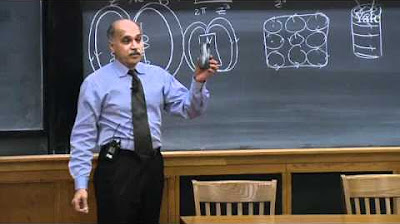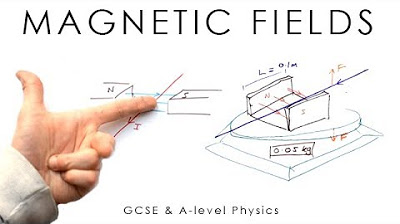Magnetism: Crash Course Physics #32
TLDRIn 1820, physicist Hans Christian Oersted made a chance discovery while lecturing - that an electric current running through a wire deflects a nearby compass needle. This demonstrated a linkage between electricity and magnetism. Today, this relationship enables much technology, from dams to phones, and protects Earth from solar radiation. Oersted found currents create circular magnetic fields. The stronger the current, the greater the field strength. Additionally, magnetic fields exert force on currents and charges. Through applications of Fleming's right-hand rule, the directions of these forces can be determined based on the directions of the current/charge and field. Ultimately, Oersted's serendipity profoundly advanced physics by revealing electricity and magnetism are intrinsically connected.
Takeaways
- 📡 Hans Christian Oersted's experiment in 1820 discovered the fundamental connection between electricity and magnetism, altering the course of physics.
- 🔬 The relationship between electricity and magnetism underpins much of today's technology, from hydroelectric dams to smartphones.
- 🚨 Earth's magnetic field plays a crucial role in protecting us from harmful solar radiation by deflecting charged particles.
- 🔄 Magnets have a north and south pole, and magnetic field lines always form closed loops around them.
- 💡 An electric current produces a magnetic field around the wire it flows through, which can be visualized with field lines forming circles around the wire.
- ✋ The first right-hand rule helps visualize the direction of the magnetic field relative to the current's direction, enhancing understanding of electromagnetism.
- 🔫 Magnets can exert force on a current-carrying wire, and vice versa, a principle that has practical applications in modern technology.
- 📈 The force exerted by a magnetic field on a wire or a charged particle depends on factors such as the current's strength, the magnetic field's intensity, and their relative orientation.
- 📲 Understanding electromagnetism is key to grasping how Earth's magnetic field deflects solar radiation, safeguarding the planet's biosphere.
- ✅ The script illustrates the importance of saving for retirement, highlighting the significant impact that even a small increase in savings can have over time.
Q & A
What did Hans Christian Oersted discover in 1820?
-Oersted discovered the connection between electricity and magnetism. He showed that an electric current running through a wire deflects a nearby compass needle.
How do you determine the direction of a magnetic field created by a current-carrying wire?
-Use the right-hand rule: Point your thumb in the direction of the current and your fingers will curl in the direction of the magnetic field lines.
What is the equation for the force exerted by a magnetic field on a current-carrying wire?
-F = IlBsinθ, where I is the current, l is the length of wire in the field, B is the magnetic field strength, and θ is the angle between the wire and field.
How does Earth's magnetic field protect us from solar radiation?
-It deflects the charged particles coming from the Sun, sending them spiraling away from Earth.
What determines the strength of the force exerted by a magnetic field on a moving charge?
-The force depends on the charge q, velocity v, magnetic field strength B, and the sine of the angle θ between the velocity and magnetic field.
What are the three right-hand rules of electromagnetism?
-1) Current to magnetic field direction. 2) Current, magnetic field, and force directions. 3) Velocity, magnetic field, and force directions on a moving charge.
Who sponsored this Crash Course physics episode?
-This episode was sponsored by Prudential.
What retirement planning tip does the sponsor provide?
-Saving an additional 1% of your income each year can significantly grow your retirement savings over time due to compound interest.
Where was this episode of Crash Course filmed?
-It was filmed in the Doctor Cheryl C. Kinney Crash Course Studio.
What other PBS Digital Studios shows are mentioned?
-First Person, PBS Game/Show, and The Good Stuff.
Outlines
😲 Discovering the Link Between Electricity and Magnetism
This paragraph describes the accidental discovery in 1820 by Danish physicist Hans Christian Oersted that an electric current running through a wire deflects a compass needle. This demonstrated the relationship between electricity and magnetism. Oersted's experiments led to the realization that an electric current produces a surrounding magnetic field. The concepts of electric and magnetic field lines are compared. The strength of magnetic fields is measured in teslas.
👉 Relating Electric Current, Magnetic Field and Force
This paragraph explains the first and second right-hand rules that help relate the direction of electric current, the magnetic field it produces, and the resulting force on the wire. It also covers the factors that determine the magnitude of the magnetic force on a current-carrying wire: current strength, wire length in the field, magnetic field strength, and their relative orientation. The protective effect of Earth's magnetic field on solar radiation is used as an example.
Mindmap
Keywords
💡magnet
💡magnetic field
💡electromagnetism
💡right-hand rule
💡Earth's magnetic field
💡solar wind
💡current
💡electromagnetic force
💡charged particles
💡tesla
Highlights
The speaker introduced a novel framework for analyzing complex systems.
A key theoretical contribution was the connectivity matrix to model relationships between system components.
The matrix enabled new insights into emergent behaviors and predictions of system perturbations.
Machine learning techniques were applied to learn patterns and dynamics from simulated data.
The approach was demonstrated on two real-world case studies in biology and economics.
For biology, the model explained how mutations can propagate through genetic networks.
For economics, the model identified vulnerabilities in the banking system to financial shocks.
The speaker discussed how the framework could inform policies to prevent system failures.
Limitations were the simplifying assumptions and lack of empirical validation.
Future directions included testing on more complex systems and dynamics.
The research provides a promising new paradigm for understanding complex system behaviors.
The generalizable methodology can be applied across many disciplines.
Overall, the work makes important advances in modeling, analysis and prediction.
It enables new capabilities for guiding policies and interventions.
There was keen interest from the audience with thought-provoking questions.
Transcripts
Browse More Related Video
5.0 / 5 (0 votes)
Thanks for rating:





